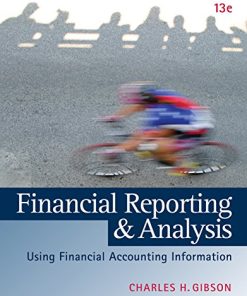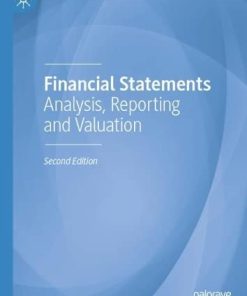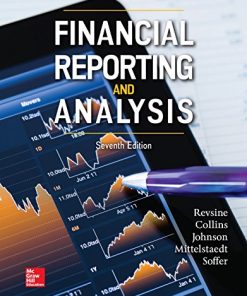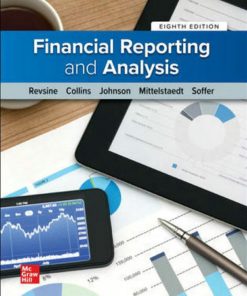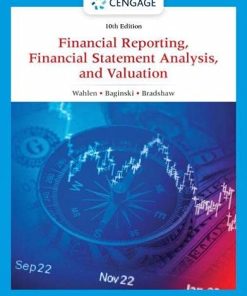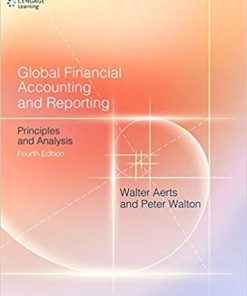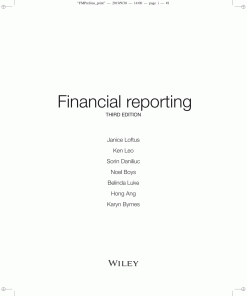Financial reporting financial statement analysis and valuation a strategic perspective 9th Edition by James Wahlen 9798214343730
$50.00 Original price was: $50.00.$25.00Current price is: $25.00.
Financial reporting, financial statement analysis, and valuation: a strategic perspective 9th Edition by James Wahlen – Ebook PDF Instant Download/DeliveryISBN: 9798214343730
Full download Financial reporting, financial statement analysis, and valuation: a strategic perspective 9th Edition after payment.
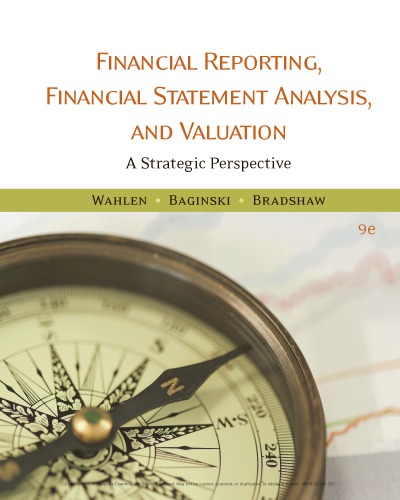
Product details:
ISBN-13 : 9798214343730
Author : James Wahlen
Learn how to conduct financial statement analysis most effectively as you perform analyses on actual, familiar companies. Wahlen/Baginski/Bradshaw’s FINANCIAL REPORTING, FINANCIAL STATEMENT ANALYSIS, AND VALUATION, 9E provides a complete, balanced approach as the authors teach you how to integrate concepts from economics, finance, business strategy, accounting, and other business disciplines through the book’s unique six-step process. Quick checks after each section help you ensure you have grasped key insights, while integrative and continuing cases highlight familiar companies, including Starbucks and PepsiCo.
Financial reporting, financial statement analysis, and valuation: a strategic perspective 9th Table of contents:
Chapter 1. Overview of Financial Reporting, Financial Statement Analysis, and Valuation
Overview of Financial Statement Analysis
How Do the Six Steps Relate to Share Pricing in the Capital Markets?
Introducing Starbucks
Step 1: Identify the Industry Economic Characteristics
Grocery Store Chain
Pharmaceutical Company
Electric Utility
Commercial Bank
Tools for Studying Industry Economics
Step 2: Identify the Company Strategies
Framework for Strategy Analysis
Application of Strategy Framework to Starbucks
Step 3: Assess the Quality of the Financial Statements
What Is Accounting Quality?
Accounting Principles
Balance Sheet—Measuring Financial Position
Assets—Recognition, Measurement, and Classification
Liabilities—Recognition, Valuation, and Classification
Shareholders’ Equity Valuation and Disclosure
Assessing the Quality of the Balance Sheet as a Complete Representation of Economic Position
Income Statement—Measuring Performance
Accrual Basis of Accounting
Classification and Format in the Income Statement
Comprehensive Income
Assessing the Quality of Earnings as a Complete Representation of Economic Performance
Statement of Cash Flows
Important Information with the Financial Statements
Step 4: Analyze Profitability and Risk
Tools of Profitability and Risk Analysis
Step 5: Prepare Forecasted Financial Statements and Step 6: Value the Firm
Role of Financial Statement Analysis in an Efficient Capital Market
The Association between Earnings and Share Prices
Sources of Financial Statement Information
Summary
Questions, Exercises, Problems, and Cases
Integrative Case 1.1. Walmart
Case 1.2. Nike: Somewhere between a Swoosh and a Slam Dunk
Chapter 2. Asset and Liability Valuation and Income Recognition
The Mixed Attribute Measurement Model
The Complementary Nature and Relative Usefulness of the Income Statement and Balance Sheet
Asset and Liability Valuation and the Trade-Off between Relevance and Representational Faithfulness
Relevance and Representational Faithfulness
Accounting Quality
Trade-Off of Relevance and Representational Faithfulness
Primary Valuation Alternatives: Historical Cost versus Fair Value
Contrasting Illustrations of Asset and Liability Valuations, and Nonrecognition of Certain Assets
Summary of U.S. GAAP and IFRS Valuations
Income Recognition
Accrual Accounting
Approach 1: Economic Value Changes Recognized on the Balance Sheet and Income Statement When Realized
Approach 2: Economic Value Changes Recognized on the Balance Sheet and the Income Statement When They Occur
Approach 3: Economic Value Changes Recognized on the Balance Sheet When They Occur but Recognized on the Income Statement When Realized
Evolution of the Mixed Attribute Measurement Model
Income Taxes
Overview of Financial Reporting of Income Taxes
Measuring Income Tax Expense: A Bit More to the Story (to Be Technically Correct)
Reporting Income Taxes in the Financial Statements
Income Taxes
Framework for Analyzing the Effects of Transactions on the Financial Statements
Overview of the Analytical Framework
Summary
Questions, Exercises, Problems, and Cases
Integrative Case 2.1. Walmart
Chapter 3. Income Flows versus Cash Flows: Understanding the Statement of Cash Flows
Purpose of the Statement of Cash Flows
Cash Flows versus Net Income
Cash Flows and Financial Analysis
The Relations among the Cash Flow Activities
Cash Flow Activities and a Firm’s Life Cycle
A Firm’s Life Cycle: Revenues
A Firm’s Life Cycle: Net Income
A Firm’s Life Cycle: Cash Flows
Four Companies: Four Different Stages of the Life Cycle
Understanding the Relations among Net Income, Balance Sheets, and Cash Flows
The Operating Section
The Relation between Net Income and Cash Flows from Operations
Preparing the Statement of Cash Flows
Algebraic Formulation
Classifying Changes in Balance Sheet Accounts
Illustration of the Preparation Procedure
Usefulness of the Statement of Cash Flows for Accounting and Risk Analysis
Summary
Questions, Exercises, Problems, and Cases.
Integrative Case 3.1. Walmart
Case 3.2. Prime Contractors
Case 3.3. W. T. Grant Company
Chapter 4. Profitability Analysis
Overview of Profitability Analysis Based on Various Measures of Income
Earnings Per Share (EPS)
Common-Size Analysis
Percentage Change Analysis
Alternative Definitions of Profits
Return on Assets (ROA)
Adjustments for Nonrecurring or Special Items
Two Comments on the Calculation of ROA
Disaggregating ROA
Return on Common Shareholders’ Equity (ROCE)
Benchmarks for ROCE
Relating ROA to ROCE
Disaggregating ROCE
Economic and Strategic Determinants of ROA and ROCE
Trade-Offs between Profit Margin and Assets Turnover
Starbucks’ Positioning Relative to the Restaurant Industry
Analyzing the Profit Margin for ROA
Analyzing Total Assets Turnover
Summary of ROA Analysis
Supplementing ROA in Profitability Analysis
Benefits and Limitations of Using Financial Statement Ratios
Comparisons with Earlier Periods
Comparisons with Other Firms
Summary
Questions, Exercises, Problems, and Cases
Integrative Case 4.1. Profitability and Risk Analysis of Walmart Stores
Chapter 5. Risk Analysis
Disclosures Regarding Risk and Risk Management
Firm-Specific Risks
Commodity Prices
Foreign Exchange
Interest Rates
Other Risk-Related Disclosures
Analyzing Financial Flexibility by Disaggregating ROCE
Analyzing Short-Term Liquidity Risk
Current Ratio
Quick Ratio
Operating Cash Flow to Current Liabilities Ratio
Working Capital Turnover Ratios
Analyzing Long-Term Solvency Risk
Debt Ratios
Interest Coverage Ratios
Operating Cash Flow to Total Liabilities Ratio
Analyzing Credit Risk
Circumstances Leading to Need for the Loan
Credit History
Cash Flows
Collateral
Capacity for Debt
Contingencies
Character of Management
Communication
Conditions or Covenants
Analyzing Bankruptcy Risk
The Bankruptcy Process
Models of Bankruptcy Prediction
Measuring Systematic Risk
Summary
Questions, Exercises, Problems, and Cases.
Integrative Case 5.1. Walmart
Case 5.2. Massachusetts Stove Company—Bank Lending Decision
Case 5.3. Fly-by-Night International Group: Can This Company Be Saved?
Chapter 6. Accounting Quality
Accounting Quality
High Quality Reflects Economic Reality
High Quality Leads to the Ability to Assess Earnings Persistence over Time
Earnings Quality versus Balance Sheet Quality
Earnings Management
Incentives to Practice Earnings Management
Deterrents to Earnings Management
Recognizing and Measuring Liabilities
Obligations with Fixed Payment Dates and Amounts
Obligations with Fixed Payment Amounts but Estimated Payment Dates
Obligations with Estimated Payment Dates and Amounts
Obligations Arising from Advances from Customers
Obligations under Mutually Unexecuted Contracts
Contingent Obligations
Off-Balance-Sheet Financing Arrangements
Asset Recognition and Measurement
Current Assets
Noncurrent Assets
Specific Events and Conditions That Affect Earnings Persistence
Gains and Losses from Peripheral Activities
Restructuring Charges and Impairment Losses
Discontinued Operations
Other Comprehensive Income Items
Changes in Accounting Principles
Changes in Accounting Estimates
Accounting Classification Differences
Tools in the Assessment of Accounting Quality
Partitioning Earnings into Operating Cash Flow and Accrual Components
A Model to Detect the Likelihood of Fraud
Financial Reporting Worldwide
Summary
Questions, Exercises, Problems, and Cases
Integrative Case 6.1. Walmart
Case 6.2. Citi: A Very Bad Year
Case 6.3. Arbortech: Apocalypse Now
Appendix 6-A. Other Examples of How SPEs are Used to Obtain Off-Balance Sheet Financing
Product Financing Arrangements
Use of Another Entity to Obtain Financing
Research and Development Financing Arrangements
Take-or-Pay or Throughput Contracts
Chapter 7. Financing Activities
Equity Financing
Investments by Shareholders: Common Equity Issuance
Distributions to Shareholders: Dividends
Equity Issued as Compensation: Stock Options
Alternative Share-Based Compensation: Restricted Stock and RSUs
Alternative Share-Based Compensation: Cash-Settled Share-Based Plans
Net Income, Retained Earnings, Accumulated Other Comprehensive Income, and Reserves
Net Income and Retained Earnings
Summary and Interpretation of Equity
Debt Financing
Financing with Long-Term Debt
Financial Reporting of Long-Term Debt
Fair Value Disclosure and the Fair Value Option
Accounting for Troubled Debt
Hybrid Securities
Transfers of Receivables
Leases
Operating Lease Method
Capital Lease Method
Choosing the Accounting Method
The New Lease Standard
The Use of Derivatives to Hedge Interest Rate Risk
Nature and Use of Derivative Instruments
Accounting for Derivatives
Disclosures Related to Derivative Instruments
Starbucks’ Derivatives Disclosures
Accounting Quality Issues and Derivatives
Summary
Questions, Exercises, Problems, and Cases.
Integrative Case 7.1. Walmart
Case 7.2. Oracle Corporation: Share-Based Compensation Effects/Statement of Shareholders’ Equity
Case 7.3. Long-Term Solvency Risk: Southwest and Lufthansa Airlines
Appendix 7-A. Accounting for Troubled Debt and Hedge Accounting for Interest Rate Swaps
An Example of Accounting for Troubled Debt
Examples of the Use of Derivatives to Hedge Interest Rate Risk
Fair Value Hedge: Interest Rate Swap to Convert Fixed-Rate Debt to Variable-Rate Debt (Scenario 1 involving Firm A)
Cash Flow Hedge: Interest Rate Swap to Convert Variable-Rate Debt to Fixed-Rate Debt (Scenario 2 involving Firm B)
Summary of Derivative Examples
Chapter 8. Investing Activities
Investments in Long-Lived Operating Assets
Assets or Expenses?
How Do Managers Allocate Acquisition Costs over Time?
Useful Life for Long-Lived Tangible and Limited-Life Intangible Assets
Cost Allocation (Depreciation/Amortization/Depletion) Method
When Will the Long-Lived Assets Be Replaced?
What Is the Relation between the Book Values and Market Values of Long-Lived Assets?
Impairment of Long-Lived Assets Subject to Depreciation and Amortization
Impairment of Intangible Assets Not Subject to Amortization
Impairment of Goodwill
IFRS Treatment of Upward Asset Revaluations
Summary
Investments in Securities
Minority, Passive Investments
Minority, Active Investments
Majority, Active Investments
Preparing Consolidated Statements at the Date of Acquisition
Consolidated Financial Statements Subsequent to Date of Acquisition
What Are Noncontrolling Interests?
Corporate Acquisitions and Income Taxes
Consolidation of Unconsolidated Affiliates and Joint Ventures
Primary Beneficiary of a Variable-Interest Entity
When Is an Entity Classified as a VIE?
Foreign Currency Translation
Functional Currency Concept
Translation Methodology—Foreign Currency Is Functional Currency
Translation Methodology—U.S. Dollar Is Functional Currency
Interpreting the Effects of Exchange Rate Changes on Operating Results
Summary
Questions, Exercises, Problems, and Cases.
Integrative Case 8.1. Walmart
Case 8.2. Disney Acquisition of Marvel Entertainment
Appendix 8-A. Translation of Foreign Financial Statements: Specific Examples
Translation Methodology—Foreign Currency Is Functional Currency
Illustration—Foreign Currency Is Functional Currency
Translation Methodology—U.S. Dollar Is Functional Currency
Illustration—U.S. Dollar Is Functional Currency
Walmart’s Consolidated Financial Statements
Chapter 9. Operating Activities
Revenue Recognition
The Revenue Recognition Problem
The IASB and FASB’s Revenue Recognition Project
Application of the New Revenue Recognition Method
Expense Recognition
Criteria for Expense Recognition
Cost of Sales
SG&A Costs
Operating Profit
Income Taxes
Required Income Tax Disclosures
Pensions and Other Postretirement Benefits
The Economics of Pension Accounting in a Defined Benefit Plan
Reporting the Income Effects in Net Income and Other Comprehensive Income
Pension Expense Calculation with Balance Sheet and Note Disclosures
Income Statement Effects
Gain and Loss Recognition
Impact of Actuarial Assumptions
Other Postretirement Benefits
Signals about Earnings Persistence
Summary
Questions, Exercises, Problems, and Cases
Integrative Case 9.1. Walmart
Case 9.2. Coca-Cola Pensions
Appendix 9-A. Legacy Revenue Recognition and Hedging Operating Risks
Topic #1: Legacy Revenue Recognition Methods
Revenue Recognition When Cash Collectability Is Uncertain
Topic #2: Use of Derivative Instruments to Hedge Foreign Currency and Commodity Price Risk
Hedging Foreign Currency Risk: Existing Asset or Liability
Hedging Foreign Currency Risk: Unrecognized Foreign Currency Commitment
Hedging Commodity Price Risk: Forecasted Future Transaction
Chapter 10. Forecasting Financial Statements
Introduction to Forecasting
Preparing Financial Statement Forecasts
General Forecasting Principles
Seven-Step Forecasting Game Plan
Coaching Tips for Implementing the Seven-Step Forecasting Game Plan
Step 1: Project Revenues
Projecting Revenues for Starbucks
Step 2: Project Operating Expenses
Projecting Cost of Sales Including Occupancy Costs
Projecting Store Operating Expenses and Other Operating Expenses
Projecting Property, Plant, and Equipment and Depreciation Expense
Step 3: Project Operating Assets and Liabilities on the Balance Sheet
Techniques to Project Operating Assets and Liabilities
Projecting Cash and Cash Equivalents
Projecting Short-Term Investments
Projecting Accounts Receivable
Projecting Inventories
Projecting Prepaid Expenses and Other Current Assets
Projecting Current and Noncurrent Deferred Income Tax Assets
Projecting Long-Term Investments
Projecting Equity and Cost Investments
Projecting Property, Plant, and Equipment and Accumulated Depreciation
Projecting Other Long-Term Assets, Other Intangible Assets, and Goodwill
Projecting Assets as a Percentage of Total Assets
Projected Total Assets
Projecting Accounts Payable
Projecting Accrued Liabilities
Projecting Insurance Reserves
Projecting Stored-Value Card Liabilities
Projecting Other Long-Term Liabilities
Step 4: Project Financial Leverage, Financial Assets, Common Equity Capital, and Financial Income and Expense Items
Projecting Financial Assets
Projecting Short-Term and Long-Term Debt
Projected Total Liabilities
Projecting Interest Expense
Projecting Interest Income
Projecting Noncontrolling Interests
Projecting Common Stock, Preferred Stock, and Additional Paid-in Capital
Projecting Accumulated Other Comprehensive Income or Loss
Step 5: Project Provisions for Taxes, Net Income, Dividends, Share Repurchases, and Retained Earnings
Projecting Provisions for Income Taxes
Net Income Attributable to Starbucks’ Common Shareholders
Projecting Dividends and Share Repurchases
Retained Earnings
Step 6: Balance the Balance Sheet
Balancing Starbucks’ Balance Sheets
Closing the Loop: Solving for Codetermined Variables
Step 7: Project the Statement of Cash Flows
Tips for Forecasting Statements of Cash Flows
Specific Steps for Forecasting Implied Statements of Cash Flows
Shortcut Approaches to Forecasting
Projected Revenues and Income Approach
Projected Total Assets Approach
Test Forecast Validity by Analyzing Projected Financial Statements
Sensitivity Analysis
Reactions to Announcements
Summary
Questions, Exercises, Problems, and Cases
Integrative Case 10.1. Walmart
Case 10.2. Massachusetts Stove Company: Analyzing Strategic Options
Chapter 11. Risk-Adjusted Expected Rates of Return and the Dividends Valuation Approach
The General Valuation Model
Equivalence among Dividends, Cash Flows, and Earnings Valuation
Expected Rates of Return
Cost of Common Equity Capital
Evaluating the Use of the CAPM to Measure the Cost of Equity Capital
Cost of Debt Capital
Cost of Preferred Equity Capital
Cost of Equity Capital Attributable to Noncontrolling Interests
Computing the Weighted-Average Cost of Capital
Dividends-Based Valuation: Rationale and Basic Concepts
Dividends-Based Valuation Concepts
Dividends-Based Valuation: Advanced Concepts
Measuring Dividends
Measuring Dividends for Starbucks
Selecting a Forecast Horizon
Projecting and Valuing Continuing Dividends
The Dividends-Based Valuation Model
Applying the Dividends-Based Valuation Model to Value Starbucks
Using the Dividends-Based Valuation Model to Value Starbucks
Sensitivity Analysis and Investment Decision Making
Summary
Questions, Exercises, Problems, and Cases
Integrative Case 11.1. Walmart
Chapter 12. Valuation: Cash-Flow-Based Approaches
Rationale for Cash-Flow-Based Valuation
Measuring Free Cash Flows
A Conceptual Framework for Free Cash Flows
How Do We Measure Free Cash Flows?
Cash-Flow-Based Valuation Models
Valuation Models for Free Cash Flows for Common Equity Shareholders
Valuation Models for Free Cash Flows for All Debt and Equity Stakeholders
Free Cash Flows Valuation of Starbucks
Starbucks Discount Rates
Valuing Starbucks Using Free Cash Flows
Valuing Starbucks Using Free Cash Flows to Common Equity
Valuing Starbucks Using Free Cash Flows to All Debt and Equity Capital Stakeholders
Necessary Adjustments to Compute Common Equity Share Value
Sensitivity Analysis and Investment Decision Making
Summary
Questions, Exercises, Problems, and Cases.
Integrative Case 12.1. Walmart: Free-Cash-Flows Valuation of Walmart’s Common Equity
Case 12.2. Holmes Corporation
Chapter 13. Valuation: Earnings-Based Approach
Rationale for Earnings-Based Valuation
Earnings-Based Valuation: Practical Advantages and Concerns
Theoretical and Conceptual Foundations for Residual Income Valuation
Example: Clean Surplus
Intuition for Residual Income Measurement and Valuation
Illustrations of Residual Income Measurement and Valuation
Residual Income Valuation with Finite Horizon Earnings Forecasts and Continuing Value Computations
Section Content
Valuation of Starbucks Using the Residual Income Model
Discount Rates for Residual Income
Residual Income Model Implementation Issues
Dirty Surplus Accounting
Common Stock Transactions
Portions of Net Income Attributable to Equity Claimants Other Than Common Shareholders
Negative Book Value of Common Shareholders’ Equity
Consistency in Residual Income, Dividends, and Free Cash Flows Valuation Estimates
Summary
Questions, Exercises, Problems, and Cases
Integrative Case 13.1. Walmart
Chapter 14. Valuation: Market-Based Approaches
Market Multiples of Accounting Numbers
Market-to-Book and Value-to-Book Ratios
A Model of the Value-to-Book Ratio
The Value-to-Book Model with Finite Horizon Earnings Forecasts and Continuing Value
Why Might VB Ratios and MB Ratios Differ from 1?
Application of the Value-to-Book Model to Starbucks
Empirical Data on MB Ratios
Empirical Research Results on the Predictive Power of MB Ratios
Price-Earnings and Value-Earnings Ratios
A Model for the Value-Earnings Ratio with Application to Starbucks
PE Ratios from a Theoretical Perspective: Projecting Firm Value from Permanent Earnings
Price-Earnings Ratios from a Practical Perspective
Benchmarking Relative Valuation: Using Market Multiples of Comparable Firms
Incorporating Earnings Growth into PE Ratios
Empirical Properties of PE Ratios
Reverse Engineering
Reverse Engineering Starbucks’s Stock Price
The Relevance of Academic Research for the Work of the Security Analyst
What Does “Capital Market Efficiency” Really Mean?
Striking Evidence on the Degree of Market Efficiency and Inefficiency with Respect to Earnings
Striking Evidence on the Use of Valuation Models to Form Portfolios
People also search for Financial reporting, financial statement analysis, and valuation: a strategic perspective 9th:
financial reporting and financial statement analysis
financial reporting financial statement analysis and valuation
financial reporting and financial statement analysis 6th sem pdf
financial reporting and financial statement analysis book
financial reporting and financial statement analysis for calcutta university pdf
Tags: Financial reporting, financial statement, valuation, strategic perspective, James Wahlen
You may also like…
Business & Economics - Accounting
Financial Statements: Analysis, Reporting and Valuation 2nd Edition
Business & Economics - Accounting
Financial Statements: Analysis and Reporting 1st Edition Felix I. Lessambo
Business & Economics - Accounting
Business & Economics - Accounting
Financial Reporting, Financial Statement Analysis and Valuation 10th Edition
Business & Economics - Accounting
Global Financial Accounting and Reporting: Principles and Analysis 4th Edition Walter Aerts




